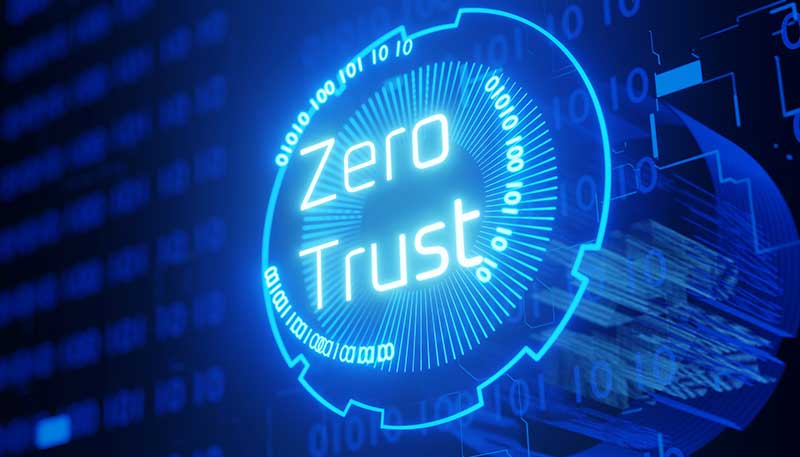Zero Trust Architecture: The Future of Cybersecurity

November 14, 2024
SEB Marketing Team
Cybersecurity strategies must advance beyond traditional security measures to meet the increasingly complex threats of the ever-evolving digital landscape. Zero Trust Architecture (ZTA) has emerged as a powerful framework for businesses, IT teams, and cybersecurity professionals designed to reinforce digital security. Let’s examines the principles, benefits, and challenges of Zero Trust Architecture and explains why it’s poised to become the future of cybersecurity.
Zero Trust Architecture: The “Never Trust, Always Verify” Model
Traditional security models often assume that users and devices within a network can be trusted, but Zero Trust operates on a “never trust, always verify” philosophy, enforcing strict access controls and continuous verification. Under ZTA, every access request undergoes rigorous scrutiny, ensuring that only verified users gain access to limited, predefined resources which fundamentally changes how digital assets are secured. The cornerstones of the framework include:
- Least Privilege Access: Zero Trust limits users’ access strictly to the data and systems necessary for their roles, reducing the potential damage if an account is compromised.
- Encryption and Protection of Sensitive Data: Data encryption, both at rest and in transit, plays a critical role in Zero Trust by ensuring that sensitive information remains protected even if intercepted. Only authorized users with the correct decryption keys can access this information, adding a vital layer of security.
- Strong Identity Verification: Multi-factor authentication (MFA) and identity access management (IAM) protocols ensure that each access request comes from an authorized user.
- Real-Time Monitoring and Analytics: Constant monitoring of user behavior and device activity helps detect anomalous actions early, preventing potential breaches before they escalate.
Key Benefits of Zero Trust Architecture
Implementing ZTA offers a range of advantages, creating a stronger and more resilient security posture. By enforcing least-privilege access and requiring strict verification of every user and device, Zero Trust significantly reduces risk exposure. Even if an attacker infiltrates part of the network, ZTA’s architecture restricts their access, limiting potential damage. Zero Trust also seamlessly integrates with advanced cybersecurity tools such as endpoint detection and response (EDR) systems and threat intelligence solutions, offering a unified and constantly validated approach to securing users, applications, data, and endpoints.
Zero Trust is especially suited for today’s hybrid and remote work models, because it ensures secure access regardless of where employees are working. This empowers organizations to expand remote capabilities safely by focusing on identity and access management instead of physical location. Additionally, with data protection regulations tightening, Zero Trust’s rigorous access management protocols and continuous monitoring support organizations in meeting compliance requirements. By controlling and monitoring access to sensitive data, Zero Trust enables organizations to better protect information and more easily fulfill regulatory obligations. Together, these benefits make Zero Trust a powerful, future-focused approach to digital security.
Challenges in Implementing Zero Trust Architecture
While Zero Trust offers compelling benefits, transitioning to a ZTA model is not without its challenges. Implementing this framework requires considerable resources, planning, and ongoing management.
Complexity and Resource Intensiveness: Implementing Zero Trust involves reconfiguring existing systems, applications, and networks. Organizations need to manage identity, access, and monitoring across a wide range of users, devices, and applications. For many businesses, especially those with legacy infrastructure, migrating to Zero Trust can be a complex, resource-intensive endeavor.
Organizational Buy-In and Change Management: Zero Trust demands cross-functional cooperation, requiring buy-in from multiple departments, including HR, finance, and IT. Companies may need to invest in training, change management strategies, and communication initiatives to ensure a smooth transition.
Continuous Monitoring and Management: ZTA requires continuous monitoring, real-time analytics, and robust logging capabilities to remain effective. This need for constant vigilance can be challenging, as it requires dedicated personnel, tools, and automated systems capable of quickly detecting and addressing suspicious activity. Some organizations may lack the cybersecurity talent needed to support the demands of ZTA, creating a skills gap that needs to be addressed for successful implementation.
Zero Trust Architecture represents an evolution in cybersecurity, offering a proactive, comprehensive approach to combating today’s sophisticated threats. By emphasizing continuous verification, strict access control, and reduced trust within networks, ZTA adapts to advanced attack tactics, keeping defenses robust and dynamic. As data volumes grow and privacy regulations become stricter, Zero Trust enables organizations to enforce precise access controls, enhancing compliance and reducing the risk of costly breaches. With its focus on identity rather than location, Zero Trust supports digital transformation and decentralized workforces, making it particularly well-suited to modern, flexible work environments. Scalable and adaptive, Zero Trust aligns with the evolving security needs of organizations, positioning itself as the solution for business leaders, IT managers, and cybersecurity professionals committed to a secure digital future.
Post navigation
Related Posts

Why Your 2026 Health Benefits Strategy Cannot Be Reactive
If you feel like you’re playing a permanent game of "whack-a-mole" with your healthcare budget,…

How to Vet a Benefits Administrator for 2026: The Data Privacy & Security Audit
By 2026, the traditional HR checklist for selecting a benefits administrator—cost, ease of use, and…

How a 90-Day Plan Saves Your Best Talent
Most companies treat onboarding as a paperwork sprint. They focus on hardware, logins, and tax…
